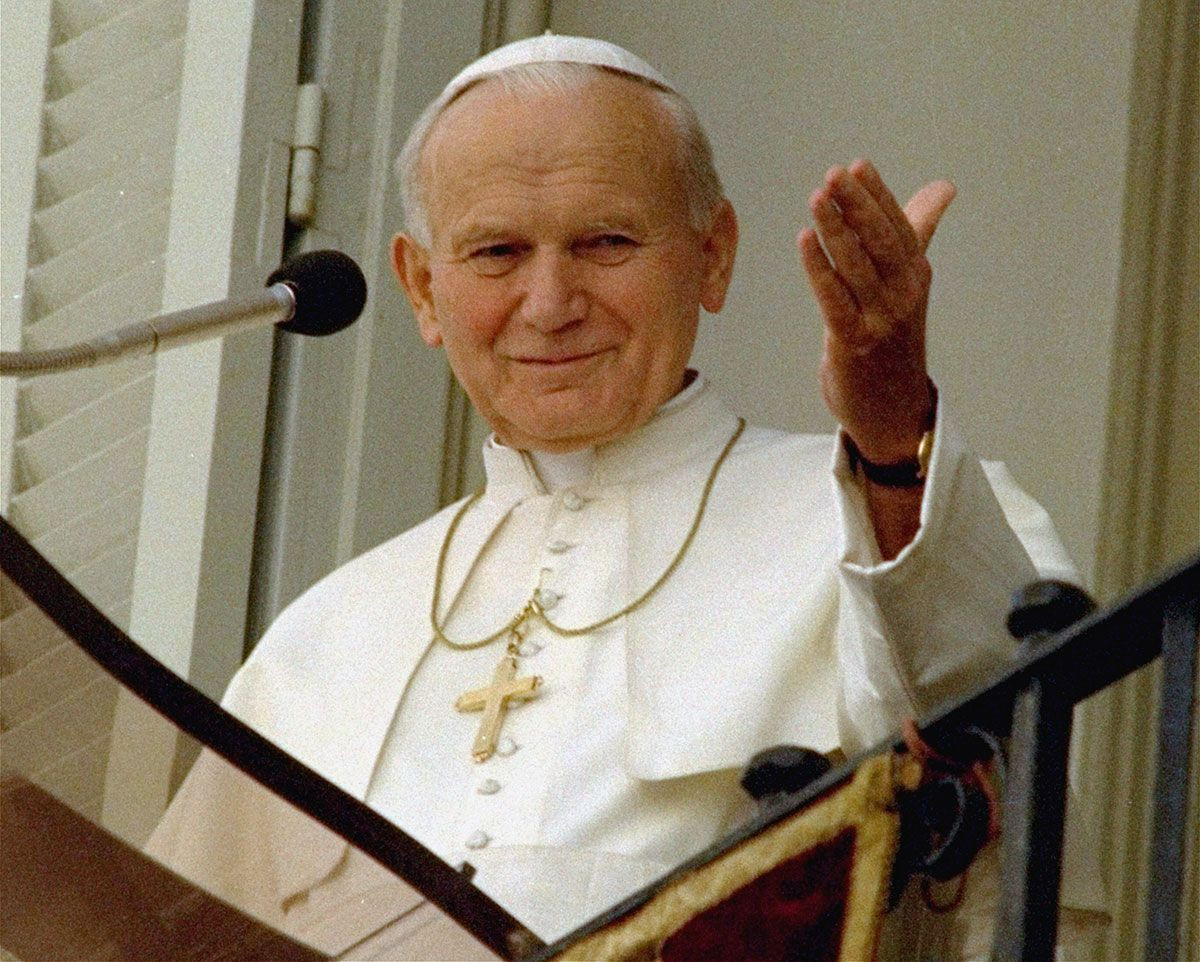 Pope John Paul II waving to pilgrims in 1989
Pope John Paul II waving to pilgrims in 1989
John Paul II, waving to pilgrims in 1989, a moment capturing his global appeal and connection with people worldwide.
St. John Paul II, originally Karol Józef Wojtyła, served as the head of the Roman Catholic Church and Bishop of Rome from 1978 until his death in 2005. His pontificate, lasting over 26 years, was one of the longest in the history of the papacy and marked a period of significant change and global engagement for the Catholic Church. John Paul II was a figure of immense global influence, revered for his role in the fall of communism, his extensive travels, and his efforts to bridge divides between religions and cultures.
Early Life and Influences of Karol Wojtyła
Karol Józef Wojtyła was born on May 18, 1920, in Wadowice, Poland. His early life was shaped by the tumultuous history of Poland in the 20th century. Growing up in the interwar period, Wojtyła experienced a brief window of Polish freedom, which instilled in him a deep appreciation for national identity and its fragility. Wadowice, his hometown, was a diverse community with a significant Jewish population, and Wojtyła’s upbringing was largely free from the anti-Semitism that would later plague Europe. He formed close friendships, including with Jewish peers, fostering a sense of interfaith understanding from a young age.
His father, Karol Wojtyła Sr., was a lieutenant in the Polish army and instilled in his son a disciplined and devout Catholic faith. Tragedy struck early in Wojtyła’s life with the death of his mother, Emilia Kaczorowska, when he was just eight years old, followed by the death of his older brother, Edmund, a physician, a few years later. Despite these losses, Wojtyła was known as an active and bright young man. He excelled academically, showed a talent for drama, and enjoyed sports, particularly football (soccer). Guided by his father, he developed a strong routine of religious observance, regularly serving at the local church and becoming deeply influenced by his confessor, Father Kazimierz Figlewicz, who provided his early Catholic instruction.
After graduating as valedictorian from secondary school, Wojtyła moved to Kraków with his father and enrolled at the Jagiellonian University. His university studies were interrupted by the Nazi invasion of Poland in 1939. The Nazi occupation brought immense suffering to Poland, with both Jewish and non-Jewish intellectuals, religious leaders, and political figures targeted for persecution.
Wartime Experiences and the Call to Priesthood
The Nazi invasion dramatically altered Wojtyła’s life and the course of Poland. Like many others, Wojtyła and his father initially fled eastward but returned to Kraków after the Soviet invasion. Under Nazi occupation, Wojtyła continued his studies in secret, attending clandestine university classes. To avoid deportation and forced labor, he worked in a quarry and later in a Solvay chemical factory, a job considered essential to the Nazi war effort. This experience made John Paul II the only pope in modern history to have worked as a manual laborer.
 Young Karol Wojtyła in Poland
Young Karol Wojtyła in Poland
A young Karol Wojtyła, whose early experiences in Poland under Nazi occupation profoundly shaped his views and future path to becoming John Paul II.
During the war, Wojtyła’s artistic and spiritual inclinations deepened. He began writing patriotic plays and joined the Rhapsodic Theatre, an underground resistance group that aimed to preserve Polish culture through secret readings of poetry and drama. He also encountered Jan Tyranowski, a tailor and lay mystic, who introduced him to the teachings of St. John of the Cross. This Carmelite mystic’s emphasis on redemption through suffering and spiritual abandonment profoundly influenced Wojtyła’s spiritual development, leading him to believe that the Church could be a powerful force for good in the world, even more so than the theater. His childhood confessor, Father Figlewicz, who had moved to Wawel Cathedral in Kraków, continued to guide him.
A pivotal moment occurred in February 1941 when Wojtyła returned home to find his father dead. This profound loss and the horrors of the Nazi occupation solidified his resolve to dedicate his life to the priesthood. By autumn 1942, he had committed to this path and began attending clandestine seminary classes run by Cardinal Archbishop Adam Sapieha of Kraków, while still working at the chemical factory. In 1944, narrowly escaping a Nazi roundup, Wojtyła spent the remainder of the war hidden in the Archbishop’s palace, disguised as a cleric. He later reflected that witnessing the Nazi atrocities, including the murder of priests, deeply clarified the meaning and importance of the priesthood for him.
From Priest to Pope John Paul II
After the war, Poland came under Soviet influence. In November 1946, Karol Wojtyła was ordained a priest by Cardinal Sapieha. His first Mass, with Father Figlewicz assisting, was held in the crypt chapel of Wawel Cathedral, a symbolically powerful location among the tombs of Polish monarchs and national heroes. He then pursued further studies in Rome, earning a doctorate in theology with a dissertation on St. John of the Cross.
Returning to Poland in 1949, Father Wojtyła was assigned to St. Florian’s parish in Kraków. He continued his scholarly pursuits, writing and lecturing on philosophy and social and sexual ethics. He earned a second doctorate, taught theology and ethics at the Jagiellonian University, and eventually became a full professor at the Catholic University of Lublin.
During this period, Wojtyła also expressed his creativity through poetry, published anonymously, exploring religious, social, and personal themes. He became a spiritual mentor to a group of young adults, joining them on kayaking and camping trips. These experiences influenced his first book, Love and Responsibility (1960), which explored the positive aspects of sexuality within marriage, a progressive view at the time.
His dynamic pastoral work, even under communist restrictions, impressed Church leaders. In 1958, Pope Pius XII appointed him Auxiliary Bishop of Kraków. John Paul II then made a significant impact at the Second Vatican Council (1962-1965), contributing to discussions on the role of the laity, interreligious dialogue, and the Church’s relationship with the modern world. Recognizing his contributions, Pope Paul VI appointed him Archbishop of Kraków in 1963, midway through the Council.
Following the Second Vatican Council, Archbishop Wojtyła served on Pope Paul VI’s Commission for the Study of Problems of the Family, Population, and Birth Rate. His involvement is believed to have influenced the encyclical Humanae vitae (1968), which reaffirmed the Church’s opposition to artificial contraception, a teaching that became controversial and widely debated.
On October 16, 1978, Karol Wojtyła was elected Pope, taking the name John Paul II. This election was historic for several reasons: he was the first non-Italian Pope in 455 years and the first Pope from a Slavic country. His election signaled a shift in the papacy towards a more global and outward-looking approach.
The Pontificate of John Paul II: A Global Papacy
The papacy of John Paul II was characterized by its global reach and impact. He became the most traveled pope in history, visiting over 129 countries. These journeys were not merely ceremonial; they were aimed at promoting peace, dialogue, and human rights. He used his travels to connect with people from diverse cultures and faiths, becoming a powerful symbol of unity and understanding.
 John Paul II's global travels
John Paul II's global travels
John Paul II’s extensive travels across the globe, demonstrating his commitment to global outreach and interfaith dialogue throughout his papacy.
Key aspects of John Paul II’s pontificate include:
-
Role in the Fall of Communism: John Paul II played a crucial role in the collapse of communism in Eastern Europe, particularly in his native Poland. His unwavering support for the Solidarity movement, his emphasis on human dignity and freedom, and his powerful speeches during his visits to Poland in the 1980s are widely credited with galvanizing opposition to the communist regime and contributing to its eventual downfall. His influence extended beyond Poland, inspiring movements for freedom and democracy across the Soviet bloc.
-
Interfaith Dialogue: John Paul II made unprecedented efforts to improve relations between the Catholic Church and other religions. He made historic gestures of reconciliation with Judaism, including visiting the Auschwitz-Birkenau concentration camp and the Western Wall in Jerusalem. He also fostered dialogue with Islam and other faiths, seeking common ground and promoting mutual respect.
-
Emphasis on Human Dignity and Human Rights: Throughout his papacy, John Paul II consistently championed human dignity and human rights. He spoke out against political oppression, violence, and materialism, advocating for the rights of the poor and marginalized. His social teachings emphasized the importance of justice, peace, and solidarity.
-
Conservative Theological Stance: While a force for change in many areas, John Paul II maintained conservative theological positions on issues such as sexual morality, the ordination of women, and the role of the laity. He upheld traditional Church teachings on contraception and abortion, and his papacy saw a centralization of authority within the Vatican. These stances were met with both praise and criticism, highlighting the complex and sometimes contradictory nature of his legacy.
-
Canonizations and Beatifications: John Paul II canonized a large number of saints – more than all of his predecessors in the previous centuries combined. This reflected his belief in the universal call to holiness and his desire to provide contemporary examples of Christian virtue.
Legacy of John Paul II
John Paul II died on April 2, 2005, in Vatican City, and was beatified in 2011 and canonized as a saint in 2014. His legacy is immense and multifaceted. He is remembered as a transformative figure who reshaped the papacy for the modern world. He enhanced the global prestige of the Catholic Church, becoming a moral and spiritual leader for billions, both Catholic and non-Catholic.
His emphasis on religious and national freedom had a profound impact on the late 20th century, contributing to the end of the Cold War and inspiring movements for democracy around the world. While his conservative theological positions remained divisive, his commitment to interfaith dialogue and human dignity left an enduring mark on the Catholic Church and global society. Saint John Paul II remains one of the most influential figures of the 20th and early 21st centuries, revered for his courage, his faith, and his unwavering commitment to humanity.

